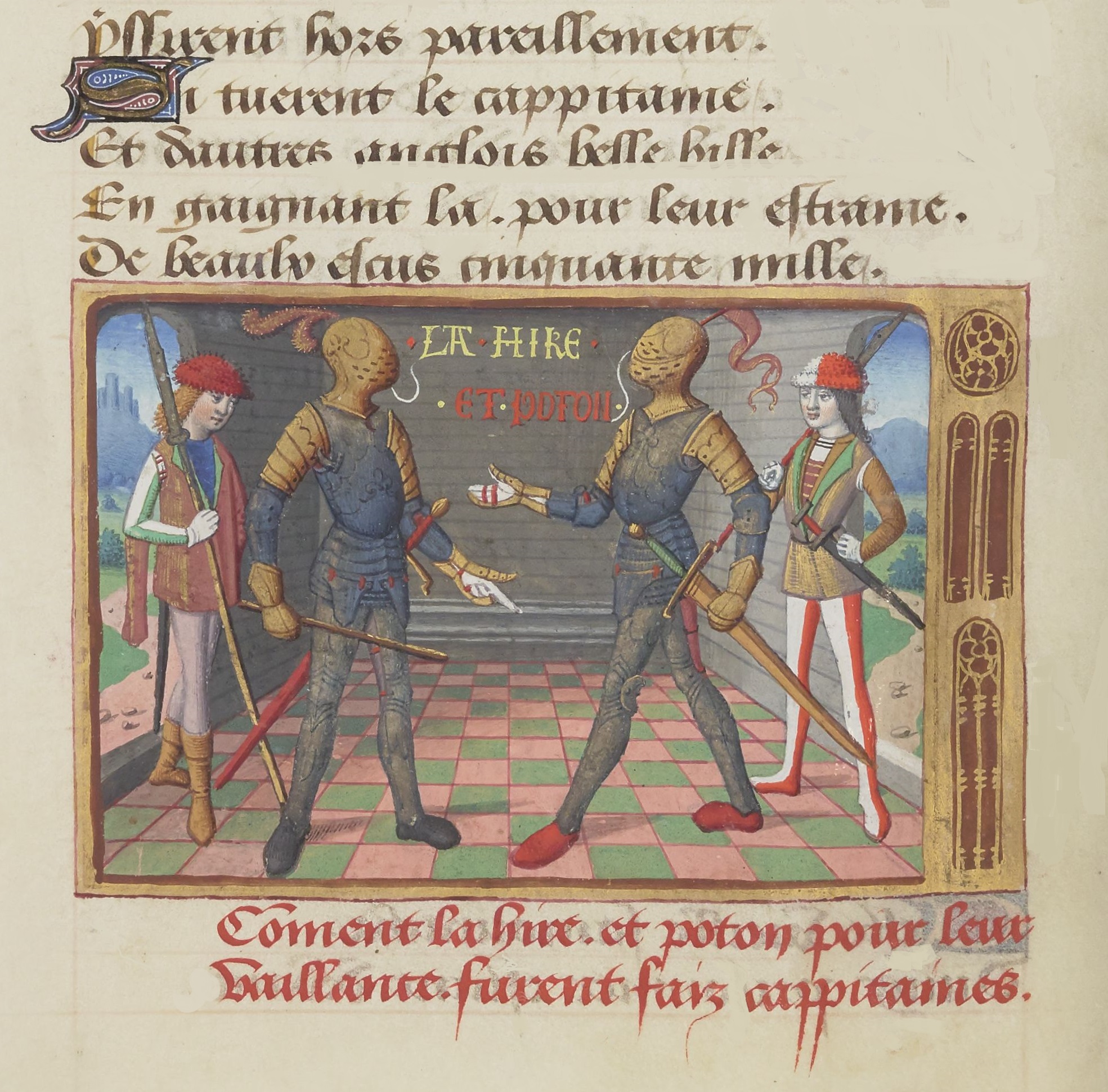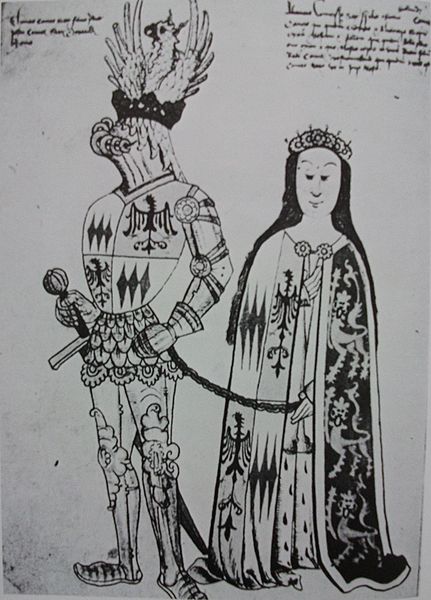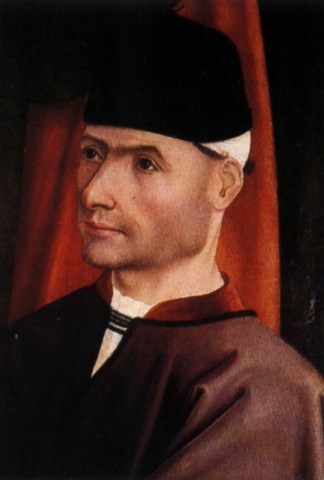The Court
 |
| Charles VII & Yolande d'Aragon |
In October 1422
Charles VII claimed the throne left vacant by
the death of his father Charles VI. By the terms of the Treaty of Troyes, following the battle of Agincourt, Henry V of England was to become king upon the death of his
father-in-law. But Henry had died in August 1422 and his infant son, Henry VI, was proclaimed king of France with his uncle the Duke of Bedford, acting as his Regent.
Charles
established his capital at Bourges[i], but by 1424 his base of
operations had been moved to Poitiers. Charles’ seemingly ineffectual nature was
overwhelmed by the ambitions of his mother-in-law, Yolande d’Aragon.
Yolande
identified Jean VI[ii],
the Duke of Brittany, as a key man to win over to Charles’ side. Jean was a
weathervane, changing the direction of his support with alarming frequency[iii]. In 1423 Jean had signed
the Treaty of Sablé along with English and Burgundians.
Yolande’s
plan was to enmesh the Duke of Brittany by wedding her son, Louis III of Anjou, to Jean’s daughter Isabel. The English played into
her hands when, in June, the Duke of Bedford stripped two of Jean’s castles to
give to one of his nobles. The marriage contract was signed on 7th
October 1425 and Charles VII, Jean de Craon and Gilles de Rais were among those
present at Saumur for the occasion. It was the first time that Gilles met Charles.
| Arthur de Richemont |
The Duke of
Brittany’s brother Arthur, Duke de Richemont[iv] was made Constable of France. De Richemont was indebted to de Craon for arranging
his ransom from the English and for setting up the negotiations leading to his
becoming Constable. De Richemont was also determined to find a place for his
cousin Georges de la Trémoille[v] at court.
The Favourites
De
Richemont, whose crude manners made him no friends at court, attacked the
English at St James de Beuvron[vi] in February 1426. There
is no evidence that Gilles was at the battle, but it is highly possible that
this violent young man was part of the French attack. Despite outnumbering the
English 20-1 the French failed to take the town. De Richemont was hampered by
his detractors at the courts of France and Brittany and his demoralised troops
were not fed or paid.
In the early
part of 1427 Yolande d’Aragon appointed the seventy year old de Craon
Lieutenant-General of Anjou[vii]. The task of raising
five companies, to join in the raids harassing the English, was given to
Gilles.
La Tremoille arms
The king’s
former favourite, Pierre de Giac, had been murdered at de Richemont’s behest[viii]. The new favourite
Camus de Beaulieu[ix]
was determined to stop anyone influencing the king. This intransigence led to
de Beaulieu being cut down by one of the Constable’s friends and his men. De
Richemont proposed that Charles take de la Trémoille as a friend, painting a
picture of his cousin’s devotion to the king, who was unimpressed;
‘A pretty story, cousin. But
you’ll live to regret it. I know him better than you do.’[x]
The Soldier
In the
summer of 1427 Gilles was serving in the campaigns, under the mentorship of an
experienced soldier, Guillaime de la Jumellière[xi], appointed by his
grandfather. The five companies were part of an army under the leadership of the veteran Ambroise de Loré. Gilles took a huge retinue and his
soldiers were well-paid; he also had a large number of spies under retainer
keeping him well informed.
La Hire (left)
St Jean de
Mortier, Ramefort and the castle of Malicorne were taken and then Gilles and
his companies went to Montargis, joining forces with de Richemont and la Hire[xii] to take the town. Gilles and his men
then travelled to Lude, where the castle[xiii] was commanded by an Englishman named
Blackburn, who had sworn to defend the castle to death.
Lord Talbot
Gilles
displayed considerable bravado in the attack, climbing over the top of the
castle wall he came face to face with Captain Blackburn and killed him. As the
hero of the day Gilles’ decision seems to have been taken as final with regard
to the prisoners[xiv].
The French then moved on to Le Mans, where they took the town, but the garrison
was relieved by the arrival of Lord Talbot[xv].
The Chamberlain
La Trémoille
had himself made Chamberlain and ensured that anyone he considered a danger to
his position of favourite was kept away from Charles. As Chamberlain he was
able to engineer the fall of de Richemont, who had few supporters at court[xvi]. His position had been
weakened by his brother Jean V’s return to the English fold in the spring of
1426. La Trémoille decided to take an interest in his naïve, rich cousin, who
was the victor of the hour.
Gilles
quickly became popular at court; he was rich, witty, handsome and more to the
point, schooled by his grandfather, unscrupulous. La Trémoille knew that Gilles
was only interested in his own pleasure. La Trémoille did not particularly care
for his cousin saying in 1435, after Gilles’ arrest;
‘It is good to advance him
in being bad.’[xvii]
Gilles had
just taken a handsome ten year old boy, Etienne Corillaut known as Poitou, into
his service[xviii].
In early
summer 1428 de Richemont made his long awaited attempt at a comeback. At
Bourges, which Charles had made his capital, de Richemont and his men invited
the townspeople to hand over the administration to himself. His men marched in
and seized Charles’ treasury and began levying taxes.
La Trémoille
raised an army and marched on Bourges; no fighting took place and on 17th
July a settlement was negotiated; an agreement that la Trémoille had no
intention of keeping.
The Earl of Salisbury
In the
meantime the English had gone onto the offensive, meaning to end the war
between the two countries permanently. Charles controlled the lands south of
the Loire, while the English held those from its north bank upwards. The plan
was to take Orléans[xix] and then on southwards.
The Earl of Salisbury landed in Calais on 24th
June with fresh troops. The fighting between de Richemont and la Trémoille
allowed the English unimpeded access to Orléans.
Soldiering Again
Jean de Dunois
The siege of
Orléans began in October and there was a failed attempt to raise the siege in
February 1429. The majority of the French commanders deserted the city, leaving
only Jean de Dunois[xx] to organise the defence. It was now
that word of a visionary shepherdess began to circulate. Joan of Arc was en route to meet with Charles,
under the protection of Robert de Baudricourt[xxi]. She was examined by members of the
court, including Yolande[xxii]; she was then examined
by members of the clergy and finally she was given permission to proceed in
March 1429.
On 8th
April 1429 Gilles de Rais agreed to serve de la Trémoille[xxiii],
‘Until death and with his
life.’[xxiv]
for the
honours given him by his cousin. It was la Trémoille who had Gilles made a
Marshall of France at the tender age of 23 and he was placed in charge of the
army that accompanied Joan to Orléans.
‘About the end of April my
Lord of Rais, Marshal of France, and many other captains, as well as common
soldiers, were assigned to the Maid.’[xxv]
During the
campaign Gilles role was to represent la Trémoille and to pass information back
to him.
Bibliography
The Hundred
Years War – Alfred Burne, Folio Society 2005
The Real
Bluebeard – Jean Benedetti – Sutton Publishing 2003
The Reign of
King Henry VI – RA Griffiths, Alan Sutton 1998
Joan of Arc
– Edward Lucie-Smith, Penguin 2000
John Talbot
and the War in France – AJ Pollard, Pen and Sword Military 2005
[i]
In the province of Berry, now in the Department de Cher
[ii]
A man with close connections to the English court, his mother Joan of
Navarre having become Henry IV’s second
wife
[iii]
His troops had been prevented from
coming to the aid of the English at Agincourt
[v]
De la Trémoille had been part of the court of the Duke of Burgundy, a prominent
ally of the English. He had fought for the French at Agincourt at been
ransomed, unlike the premier noble of France, the Duke
of Orléans
[vi]
Near Avranches
[vii]
Involving the levying and command of troops
[ix]
Commander of one of the companies of the royal guard and a protégé of de
Richemont
[x]
The Real Bluebeard - Benedetti
[xi]
Shown in Gilles’ accounts as Monseigneur de Martigné
[xii]
Étienne de Vignolles, one of the French
army commanders
[xiii]
Built as part of the defences for Anjou
[xiv]
The English were freed, but the French collaborators put to death, although
many of his co-fighters were dismayed at the loss of ransom possibilities
[xv]
The English Constable of France and Earl of Shrewsbury; by June 1428 Maine was
back under English control
[xvi]
De la Trémoille also appears to have helped destroy Joan of Arc, both actions
of jealousy, crippling the French by ridding the army of their best commanders
[xvii]
Ibid
[xviii]
Poitou was to go to the stake with Gilles
[xix]
Whose duke was a prisoner in England
[xx]
Half brother of the imprisoned duke; also known as the Bastard of Orléans
[xxi]
Captain of the royal garrison at Vaucouleurs
[xxii]
Who tested her virginity
[xxiii]
One of his distant cousins, first met during the Brittany-Dauphin feud
[xxiv]
Joan of Arc – Lucie-Smith
[xxv]
The Real Bluebeard - Benedetti





No comments:
Post a Comment
Note: only a member of this blog may post a comment.